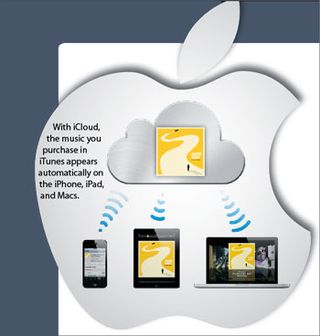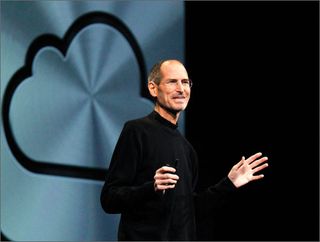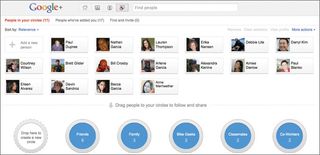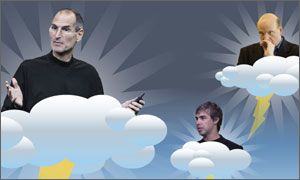Who Will Win the Cloud War? Apple vs. Google vs. Microsoft

The cloud and its promises of web-based software, near limitless storage, and streaming media services, has long been predicted as the next arena for the tech industry’s heavyweights to do battle. While Google and Microsoft have been offering cloud services for years, each company has focused more on advanced or enterprise users. Then, in June, Apple unveiled iCloud, which, when it launches this fall, will attempt to do what the competition has failed to do: make the cloud ubiquitous without being intimidating.
So what is the cloud in 2011? What do these companies stand to gain by winning over the most users? And who is in the best position to win?

Defining the Cloud
Although the cloud and the various services it supports have been around for quite some time, tech companies have done a fairly poor job of explaining exactly what the cloud is. “When you say cloud services, it’s pretty broad,” explained Michael Gartenberg, research director with the technology research firm Gartner. “Are you talking about digital lockers? Are you talking about cloud-based applications? Streaming music services? Cloud sort of becomes one of those catch-all phrases that becomes hard to define.”
In truth, the cloud is a nebulous term to describe the Internet and the various ways it can be leveraged by users.
For example, cloud storage allows users to upload and access their data via the web, much like an Internet-connected hard drive. When you upload a document or photo to Dropbox, you are storing it on the company’s servers, which allows you to access your files from any computer. Playing a game on Facebook? That also uses the cloud as a backbone.
Cloud-based applications, such as Google’s Docs productivity suite and online music services such as Grooveshark and Pandora, give users access to programs that they previously would have had to install on their PC. Such services save precious resources on users’ computers. However, most of these cloud apps require an active Internet connection. If you’re offline, for the most part you’re out of luck.
Stay in the know with Laptop Mag
Get our in-depth reviews, helpful tips, great deals, and the biggest news stories delivered to your inbox.
The Stakes
Unlike the desktop software of the past, which usually generated revenue through one-time purchases, the cloud carries with it the prospect of yearly subscription fees based on the types of services users sign up for. According to industry analyst Danielle Levitas of IDC, the cloud offers companies the chance to lock in users for a previously unprecedented amount of time.
“What everybody in the Internet space hopes for is getting some sort of annuity,” Levitas said. “There is a distinct advantage to getting people to sync and store to your cloud service, because it’s a major pain to move from one platform to another.” The hassle of moving to a different service, Levitas said, helps to ensure that users will stick with one company for a fairly long amount of time. The notion that users will stay with one service over another to avoid the hassle of moving all of their files to new service could have a huge impact on Apple, Google, and Microsoft’s overall mobile strategies.
Each company either currently offers or is working on integration of their cloud services with their mobile operating systems, with a majority of those services being made available free of charge. Apple, for instance, is deeply integrating iCloud with iOS 5 and OS X Lion, which will make transfering files between your Mac, iOS device, and iCloud fairly simple. Apple, however, has no plans to release an iCloud app for Android or Windows Phone 7 devices, meaning that if you rely heavily on iCloud and want to be able to access the service on the go, you’re going to opt for an iOS 5 device.
Microsoft is banking on a similar strategy with its Windows Phone 7 and Windows Live integration, which allows users to upload photos, songs, and documents from their phones directly to their Windows Live Skydrive accounts. Without a Windows Phone 7 device, uploading your data from your mobile device is out of the question.
Google, meanwhile, ensures that most Android devices ship with a slew of shortcuts to the company’s various cloud services. By doing this, Google gives users incentive to purchase an Android device. Of course, you could always access something like Gmail through your mobile device’s web browser, but having the service fully integrated into your device makes the process much quicker.
Taking all of this into account, it wouldn’t be too much of a stretch to say that the cloud wars could help determine who wins the mobile platform wars. With so much at stake, it behooves tech companies to offer users exciting and worthwhile services to keep them coming back for more. So how exactly are Apple, Google, and Microsoft trying to accomplish this?
The Cloud According to Apple
With the unveiling of its iCloud in June and its ability to galvanize the marketplace, Apple has almost single-handedly turned mainstream consumers’ collective gaze toward the cloud. “Apple’s iCloud got everybody refocused,” Levitas said. “And frankly, because of what they do so well in terms of their marketing, I think that will go a long way in helping to educate end users—specifically consumers—on what to expect from the cloud.”

Unlike a traditional cloud service, where users manually upload and download their data, Apple’s approach takes the work out of the equation. Accessing the service, for example, is as simple as downloading iOS 5 or buying a device with the software pre-installed. Many aspects of the service are attached to already-existing programs, such as iTunes, and take place behind the scenes.
For instance, when a user purchases content through the iTunes store, whether it is a song, movie, or television show, iCloud will automatically download the content onto each iOS 5-equipped device that person owns. The service will also tell users what items they have purchased but have yet to download on a particular device.
Apple is also rolling out Scan and Match, a feature that will scan your music library for songs and upgrade them to 256 Kbps AAC DRM-free version files, even if they were not originally purchased through iTunes. The service is expected to cost $24.99.
Cupertino is taking a similar approach to photo sharing. With iCloud, photos that users capture with an iOS 5 device are automatically pushed to their other iOS 5 mobile devices. Photos will be stored for up to 30 days on Apple’s servers, while each mobile device will store the 1,000 most recent photos. Mac OS X Lion users will be able to store as many photos as their hard drives can handle.
In addition to multimedia features, iCloud includes document back-up and sharing. Documents edited in iWork and saved on an iOS 5 device or Mac running OS X Lion are automatically updated across every iCloud-equipped Apple device. Currently, the service only works with iWork, but Apple says it is working with third-party app developers to give users more of a choice in what software they use. Because the majority of the service‘s features require users to have iOS 5 or OS X Lion, PC users won’t be able to access all aspects of iCloud.

iCloud will also be taking the place of MobileMe, Apple’s previous cloud-based offering that cost $99 per year. Like MobileMe, iCloud will store users’ calendar events, contacts, and e-mail online, but unlike MobileMe, iCloud will be offered to users free of charge. When users make a new contact on their iPhone, the information will be stored in the cloud and automatically pushed to their other iOS 5 devices. Apple’s Calendar works the same way it did in MobileMe, but it now allows for easier sharing of calendars across devices. E-mail is also included with iCloud and will not have advertisements.
In addition to automatically syncing users’ information across multiple devices, iCloud will offer users up to 5GB of free online storage that can be used to store e-mail, documents, account information, and app settings. Purchased music, apps, and eBooks—as well as users’ photo streams—do not count against the 5GB cap.
For all that it offers, iCloud does have potential drawbacks. In particular, Levitas pointed to the fact that many of iCloud’s automatic syncing features require Apple hardware, specifically devices using iOS 5. More tech-savvy users may also find iCloud’s lack of customization options to be a hindrance.
“For people that are using Sugarsync and Dropbox and Box.net, they will pooh-pooh certain aspects of [iCloud] because, for instance, it is only making 1,000 of your most recent pictures available,” Levitas said. But for the mass market that is not using these services, iCloud is going to make it seem compelling and easy to use.”
But don’t be surprised if Apple announces additional functions for iCloud down the line. “Apple has certainly unveiled publicly part of what they are doing,” said Gartenberg. “But, as is typical Apple fashion, it’s likely they probably haven’t revealed every detail about the service and how the entire service is going to work. So we are probably going to have to wait a little bit to fully evaluate it.”
Google’s Cloud
Just in case you hadn’t heard, Google is nearly synonymous with the cloud. From Google Docs suite and Google Picasa Photos to Gmail, Google Maps, and YouTube, the company has been offering free web-based software for years. And, as Levitas points out, none of Google’s software offerings require users to purchase a particular piece of hardware, as iCloud does. As long as you have a compatible web browser and an active Internet connection, you can access any of Google’s web-based applications. Mobile users have a nearly equal amount of access to Google’s services as well, via the company’s Android- and iOS-compatible apps, or through their mobile device’s browser. And yet the majority of Google’s apps are built into the Android OS, which makes accessing them on an Android device faster and easier, and makes purchasing an Android device much more desirable for users of services such as Gmail, Google+, and Google Talk.
Recently, Google launched Google Music Beta, a cloud-based service that allows users to upload 20,000 songs from their music libraries to Google’s servers and stream those tunes through a web browser or Android phone. As the name suggests, the service is still in beta, and there is currently no fee for the service, but don’t expect that to be the case when the finished product goes live. Like iCloud, Music Beta syncs your music across your computer, smartphone, and tablet, allowing you to access it whenever you want (as long as you have an Internet connection).

Unfortunately, uploading your music collection can be a very time-consuming process. Apple’s iCloud, on the other hand, doesn’t require you to upload your music. The difference goes back to Apple’s ability to strike deals with several record companies, which gives iCloud access to the labels’ libraries. Google was unsuccessful in reaching those deals in time for launch.
Overall, Google’s approach to the cloud is to make it fully customizable for each user. While iCloud integrates the cloud as part of already-existing programs, Google has developed a multitude of programs specifically for the cloud. However, each of Google’s cloud-based programs are separate. This disconnect between applications is one of the biggest criticisms analysts have leveled against Google’s cloud strategy.
“Google has been the cloud, but it’s all of these disparate capabilities,” Levitas said. “I think for the consumer that’s a nightmare. It may be fine for small businesses, but I think for individuals, it’s ‘Wait, what are all of the different things I can do depending on which service I click on?’”
The fact that Google has so many separate properties may allow it to offer best-in-class verticals, but in order to make cloud-based storage, synchronization, and streaming a reality for the mass market, it has to be integrated, and it has to be easy. “You need it to be stupid-simple, and with Apple the notion is that you take a picture and it automatically syncs to the cloud,” said Levitas.
Google+ could be a very important step toward making things simpler for users. Google’s new social-networking service has many of the same features as Facebook but offers integration with Google’s other web-based offerings.

For example, photo sharing is heavily integrated with Picasa, which will soon be known as Google Photos. Because of this integration, Android phone owners who install the Google+ app can automatically upload their photos to the cloud. So far the automatic upload feature is only a part of the Google+ app and not fully integrated with the Android OS, but that’s likely on the way.

Microsoft Goes Live
Microsoft’s cloud strategy is somewhat of a hybrid of the approach being taken by Apple and Google. The company is offering online storage, streaming, and syncing under one suite like Apple, while still giving users the type of customization offered by Google. A large part of Microsoft’s cloud strategy revolves around its Windows Live suite, which includes the recently revamped Skydrive, as well as Hotmail, Office Live, and Windows Messenger. Microsoft is hoping to offer users a complete cloud experience without drawing them away from their tried-and-true desktop software offerings.
With Skydrive, Microsoft allows users to upload and store data to the cloud, including documents, photos, and videos, while the company’s Live Mesh helps users sync up to 200 files, each with up to 50GB of data, across multiple Windows computers. When a folder is synced between computers, changes made to the folder on one PC are automatically made to the synced files on the other PC, as long as both systems are online. Windows Live Photo Gallery and Movie Maker give users access to web-based photo and video editing tools.
Office Live offers a web-based—albeit slightly stripped-down—version of the company’s desktop-based Office suite, and it allows users to access and edit their documents online via Microsoft’s Windows Live service. Office 365, on the other hand, is available in two versions and is specifically tailored to the needs of small and medium-sized businesses. Office 365 for professionals and small businesses is a $6 per user per month subscription service for businesses with less than 25 employees and no IT staff or experts. It provides users with access to their e-mail, documents, calendar, and contacts from most mobile devices. Office 365 for midsized businesses and enterprises is designed for companies with more serious IT needs and includes Active Directory integration, e-mail archiving, and 24-hour tech support.
Like Apple’s iCloud, Skydrive syncs with phones (on the Windows Phone platform). This means that the first time you turn the phone on, you can download your contacts, e-mail, calendars, photos, and music. Dharmesh Mehta, Microsoft’s director of Windows Live, explained that the service also automatically pushes photos taken on your Windows Phone to your Skydrive folder. Android and iOS users can also upload and download files to Skydrive, but they will have to use their devices’ web browsers to do so.
Despite its cloud offerings, Gartenberg says that Microsoft is still somewhat hamstrung because of how much the company relies on its desktop software offerings as a source of revenue. “They are certainly cognizant of the effort [to move to the cloud], but at the end of the day they built their business on PC-based software, and I think these things [Office Live] are adjuncts to that; not necessarily designed to replace them, but designed to complement,” Gartenberg explained.
Still, Microsoft deserves credit for integrating the cloud more deeply in the upcoming Windows 8 operating system. The Mail, Calendar, People, Messages, and Photo apps will all be in sync with online services. Microsoft is also connecting apps to one another so you can share info via the cloud with friends and family on the fly.

Who Will Win?
Despite the multitude of offerings available from each of these companies, the prevailing wisdom seems to be that it’s just too soon to determine which company’s strategy is best. “I think there are a lot of different scenarios,” Gartenberg said. “The answer is, we just don’t know everything about what everyone is doing now.”
Gartenberg believes Google’s failure to fully integrate its web-based offerings and its Android and Chrome operating systems is a response to the public being unready to move to the cloud. “Google seems to be taking several approaches. On the one hand, they are certainly focusing on entirely cloud-based services with Chrome OS and Chromebooks. On the other hand, they seem to be hedging those bets to some degree in the short term with Android and rich applications,” he said.
Since most consumers don’t seem to be ready to embrace an entirely cloud-based experience, Apple, Google, and Microsoft will integrate cloud services into more of their applications to indoctrinate more users.
However, to some, Apple and its iCloud are looking more and more like the favorite even before it’s launched. “With Apple, there will be less setup, which is what the mass market needs,” Levitas said. “Simplicity to me will trump features and functions in this space.”
